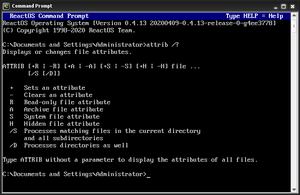ATTRIB
In computing, ATTRIB is a command in Intel ISIS-II,[1] DOS, IBM OS/2,[2] Microsoft Windows[3] and ReactOS[4] that allows the user to change various characteristics, or "attributes" of a computer file or directory. The command is also available in the EFI shell.[5]
 The ReactOS attrib command | |
| Developer(s) | Intel, IBM, Microsoft, DR, Datalight, Novell, Phil Brutsche, ReactOS Contributors |
|---|---|
| Initial release | 1984, 35–36 years ago (DOS version) |
| Operating system | ISIS-II, PC DOS, MS-DOS, MSX-DOS, SISNE plus, OS/2, Windows, DR DOS, ROM-DOS, FreeDOS, ReactOS, SymbOS |
| Type | Command |
| License | FreeDOS, ReactOS: GPLv2 |
History
Several operating systems provided a set of modifiable file characteristics that could be accessed and changed through a low-level system call. For example, as of release MS-DOS 4.0, the first six bits of the file attribute byte indicated whether or not a file was read-only (as opposed to writeable), hidden, a system file, a volume label, a subdirectory, or if the file had been "archived" (with the bit being set if the file had changed since the last use of the BACKUP command).[6] However, initial releases of the operating system did not provide user-level method for reading or changing these values.[7]
The initial version of the ATTRIB command for DOS was first included in version 3.0 of PC DOS, with functionality limited to changing the read-only attribute.[7] Subsequent versions allowed the read-only, hidden, system and archive bits to be set.[8] MS-DOS version 3.3 added the capability of recursive searching through subdirectories to display attributes of specified files.[9]
Digital Research DR DOS 6.0[10] and Datalight ROM-DOS[11] also include an implementation of the ATTRIB command.
The FreeDOS version was developed by Phil Brutsche and is licensed under the GPLv2.[12]
Uses
Setting the read-only bit of a file provided only partial protection against inadvertent deletion: while commands such as del and erase would respect the attribute, other commands such as DELTREE did not.[13] Changing the system attribute was not possible in early versions of Windows, thus requiring use of ATTRIB.[13] Similarly, a system crash in early versions of Windows could lead to a situation where a temporary file had the read-only bit set and was additionally (and irrevocably) locked by the Windows OS; in this instance, booting into DOS (thus avoiding the Windows lock) and unsetting the read-only attribute with ATTRIB was the recommended way of deleting the file.[14] Manipulating the archive bit allowed users to control which files were backed up using the BACKUP command.[7]
See also
chattr, the equivalent on Unix and Linuxcacls, the Windows NT access control list (ACL) utility- List of DOS commands
References
- ISIS II Users Guide
- http://www.jatomes.com/Help/Os2Cmd.php#ATTRIB
- Microsoft TechNet Attrib article
- reactos/attrib.c at master · reactos/reactos · GitHub
- "EFI Shells and Scripting". Intel. Retrieved 2013-09-25.
- IBM Disk Operating System Version 4.00 Technical Reference (1st ed.). July 1988. p. 3:5.
- Petzold, Charles (June 10, 1986). "Changing DOS File Attributes". PC Magazine. pp. 249–262.
- "DOS Attrib". Encyclopedia. PC Magazine. Retrieved 2007-08-02.
- "Using ATTRIB, CHKDSK, or DIR Command to Locate Files". Microsoft. Archived from the original on 2014-09-01. Retrieved 2017-11-01.
- "DR DOS 6.0 User Guide Optimisation and Configuration Tips" (PDF). Archived from the original (PDF) on 2019-09-30. Retrieved 2019-08-13.
- "Datalight ROM-DOS User's Guide" (PDF). www.datalight.com.
- http://www.ibiblio.org/pub/micro/pc-stuff/freedos/files/distributions/1.2/repos/pkg-html/attrib.html
- O'Reilly, Tim; Mott, Troy; Glenn, Walter J. (1999). Windows 98 in a Nutshell: A Desktop Quick Reference. O'Reilly. pp. 303–306. ISBN 1-56592-486-X.
- Jones, James G.; Landes, Craig (2003). A+ Exam Cram 2: Windows 2000 Directory Services Infrastructure. Que. pp. 309–310. ISBN 0-7897-2867-2.
Further reading
- Cooper, Jim (2001). Special Edition Using MS-DOS 6.22, Third Edition. Que Publishing. ISBN 978-0789725738.
- Dyson, Peter (1995). Mastering OS/2 Warp. Sybex. ISBN 978-0782116632.
- John Paul Mueller (2007). Windows Administration at the Command Line for Windows Vista, Windows 2003, Windows XP, and Windows 2000. John Wiley & Sons. ISBN 978-0470165799.
External links
| Wikibooks has a book on the topic of: Guide to Windows Commands |